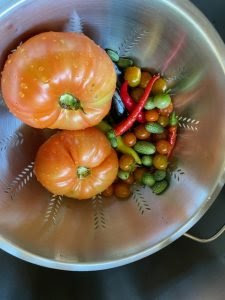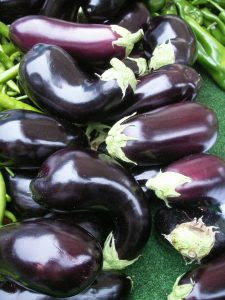Your vegetable garden is likely approaching peak production time—but when and how to harvest? Even if you are a pro, here’s how to make sure those caring for your precious crops while you’re away know when to pick!
What matters about harvest time?
- Harvest stage affects flavor and yields:
- Picking too soon not only reduces the amount of food your garden produces but also may mean missing that perfectly ripened taste—although not all vegetables lose flavor after picking.
- Waiting too long definitely means missing the best flavor—think sweet corn turned starchy—and your produce actually spoils. Crops literally go to seed have accomplished their goal and will stop producing!
- Factors that affect harvest and storage.
- Warmer temperatures after picking can affect flavor—crops like peas and sweet corn that turn starchy, for example, need immediate cooling. Joseph Masabni of Texas A&M Extension, advises “harvest these vegetables early in the morning or right before you intend to use them.”
- Not all crops benefit from refrigeration, however! And humidity levels and air circulation are important, too! If you’re not going to use your bounty immediately, some crops, such as garlic, dry onions, potatoes, and tomatoes are best stored only at room temperature, according to UC-Davis Post Harvest Technology specialists (see below). They also recommend that cucumbers, eggplants, and peppers be refrigerated only for 1 to 3 days and then used as soon as you remove them from the cold.
- Advise those harvesting in your absence how often you check your crops, and which are most time-sensitive!
Things to look for when you harvest
Harvesting takes more time than you’d expect—look carefully for items to pick amongst all those leaves and vines. This makes harvesting a great time to give your garden plants a quick check-up!
- Size matters!
- Color changes are usually important, too.
- Tomatoes turning red are an obvious example, but how red is the best time for picking? Maybe earlier than you think! Picking at the “breaker” stage rather than fully red means your tomatoes will continue to ripen indoors, taste vine-ripened, but won’t suffer sunscald, or damage from insects or birds.

Tomatoes will develop full flavor ripened indoors if picked once they begin to show some color. - Cucumbers should still be uniformly green, not starting to yellow.

Cucumbers are best picked green rather than starting to yellow. - Eggplants should be purple (light or dark depending on the variety), but still glossy, not dull

Pick eggplants while the skin is still glossy. - Watermelons, on the other hand, should develop a duller, rougher surface and the spot touching the ground should be yellowing, not white

Ripe watermelon skin should be starting to dull and roughen and the ground spot turning yellow. - .Detecting defects may mean removing fruits before they take any more resources from the plant—think blossom-end rot on tomatoes or peppers—or harvesting while part of the crop is still salvageable—such as a nip out of an otherwise healthy tomato.
- Damage may alert you to insect infestations—minimize or eliminate, by hand-picking the culprits—such as snails or slugs—or treating to prevent further damage—wash away aphids on greens or treating pickleworm infestations of cucumbers and squash with pesticides, for example. Learn which “bugs” you see are pests and which are helpful predators!
- Harvest “helpers” will be more eager to volunteer if they pick at the right time—and you won’t find all your tomatoes gone despite their size or plants loaded with overripe items bringing production to a halt. Alerting you to any emerging problems is another bonus.
- Tomatoes turning red are an obvious example, but how red is the best time for picking? Maybe earlier than you think! Picking at the “breaker” stage rather than fully red means your tomatoes will continue to ripen indoors, taste vine-ripened, but won’t suffer sunscald, or damage from insects or birds.
“Harvesting” spent plants?
While picking your crops pick off dead leaves, spent blossoms, and trim errant runners to keep plants looking good and productive. Knowledgeable helpers can perform these tasks.
In WNC, most vegetable garden plants are annuals, or treated as such, so when you harvest, evaluate when it’s time to pull the whole plant—it may be too risky to ask short-term caregivers to make this decision!
- Is the plant diseased? If there are signs of disease, either do what you can to remove diseased portions, treat the problem, or remove the entire plant.
- Is production slowing?
- Review fertilizing or watering practices to improve yields. Most crops need an inch of rain a week to prosper—water established plants deeply once a week if rains are insufficient. Check your crops’ needs for fertilizer and the application rates recommended for the fertilizers you are using.
- Extreme temperatures may interfere with fruit set or how your crops ripen. Be patient if better weather will solve the problem! Note, though, that spring crops that fade with high temperatures are long gone; so too, frosts will damage tender crops, so harvest these before freezing temperatures.
- Once you’ve decided your plants have passed peak production, pull the plants and consider planting a fall crop. See the calendar below for all the crops you can plant in August for a bountiful autumn harvest!
Article by Buncombe County Extension Master GardenerSM Volunteers
For more information:
When to harvest specific crops: https://content.ces.ncsu.edu/extension-gardener-handbook/16-vegetable-gardening#vegetableharvestingguidelines
https://agrilifeextension.tamu.edu/library/gardening/harvesting-handling-vegetables-garden/
Ripening after harvest:
https://gardenprofessors.com/ripening/
https://www.johnson.k-state.edu/lawn-garden/agent-articles/vegetables/harvest-ripen-tomatoes.html
Storing produce:
http://postharvest.ucdavis.edu/files/230110.pdf
Planting times for WNC:


